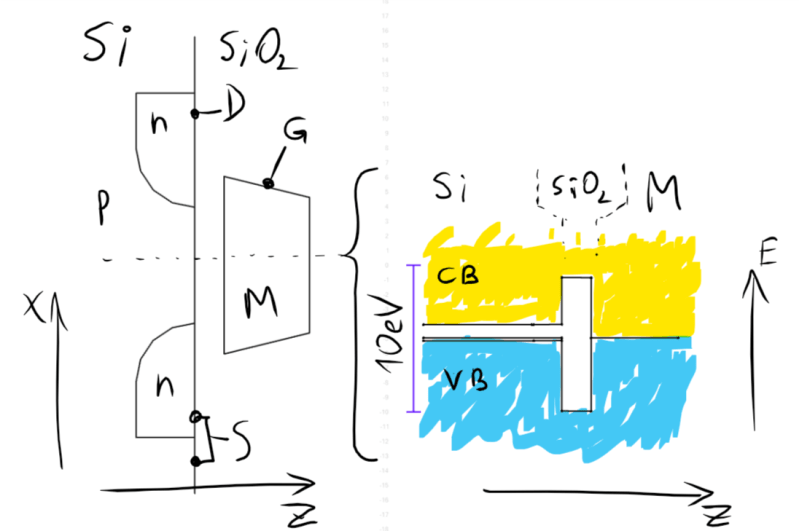Since the 1940s when the first transistor was created, transistors have evolved from ornery blocks of germanium wrangled into basic amplifiers into thousands and thousands of different devices made of all kinds of material that make any number of electrical applications possible, cheap, and reliable. MOSFETs can come in at least four types: P- or N-channel, and enhancement or depletion mode. They also bear different power ratings. And some varieties are more loved than others; for instance, depletion-mode, N-channel power MOSFETs are comparatively scarce. [DeepSOIC] was trying to find one before he decided to make his own by hacking a more readily available enhancement-mode transistor.
For those not intimately familiar with semiconductor physics, the difference between these two modes is essentially the difference between a relay that is normally closed and one that’s normally open. Enhancement-mode transistors are “normally off” and are easy to obtain and (for most of us) useful for almost all applications. On the other hand, if you need a “normally on” transistor, you will need to source a depletion mode transistor. [DeepSOIC] was able to create a depletion mode transistor by “torturing” the transistor to effectively retrain the semiconductor junctions in the device.
If you’re interested in semiconductors and how transistors work on an atomic level, [DeepSOIC]’s project will keep you on the edge of your seat. On the other hand, if you’re new to the field and looking to get a more basic understanding, look no further than these DIY diodes.
















Well that’s pretty hardcore hacking, I’ll give it that.
+1
hmmm, I wonder if this could be used to thwart reverse engineering. The way I see it is that the hacker copies the part numbers from the transistors to get spec sheets only to find out that the circuit operation does not behave as the transistors imply. I know I know…. Security through obscurity is not real security at all.
I think you’d struggle to use these transistors in mass production as their characteristics will be somewhat unpredictable. There’ll be lots of variance which means additional expense in testing and possibly unreliability in shipped products.
It’d work for a prototype or one-off, but I wouldn’t run a production line on this method.
Agreed but there has to be some edge case of a transistor that behaves consistently with this method..
It’d be *much* easier to just take a dremel tool to the case and remove the markings. Heck, you could even order chips with the wrong silkscreen and get the same effect without any of the unpredictability.
Interesting, Alan. You make a good argument for this type of usage. After discussing with some IEEE buddies, they hashed it out and replied that seasoned engineers would be able to differentiate the transistor and its effects making the part numbers ineffective anyway with reverse engineering. (due to the fact that many packages are obfuscated with a healthy glob of epoxy covering the part number)
I dunno about the torture part. For some reason I had the vision of a transistor being waterboarded.
Those fools, using de-ionized water… they’ll never break me down!!!
So how long until things migrate back to where they were and your circuit fails?
I’m not sure if the parameters will ever recover to their datasheet values. I have a BUZ11A that has an original threshold gate voltage of 3.84V. About 10 days ago, the transistor was modified from Vt = 3.84V to Vt = 1.6V, and it’s still keeping its modified Vt = 1.6V
He’s damaging the gate oxide and creating traps that collect carriers. The carriers will bake out at high (150C) temperature, but the damage will never go away and new carriers can be trapped.
You usually try to avoid this kind of stuff with mos switches, but if it works for you – go for it! See if your threshold recovers if you run the device hot for a while. And it’s probably worthwhile to measure your new gate leakage current with an ohmmeter on resistance mode to make sure it’s not loading your port too bad.
“The carriers will bake out at high (150C) temperature” Maybe, I need to test it.
“And it’s probably worthwhile to measure your new gate leakage current with an ohmmeter on resistance mode to make sure it’s not loading your port too bad.” The leakage current is so small I can apply voltage to gate with fingers, and it remains there when I release fingers. I often use this trick as a quick way to test mosfets.
Tested. Mosfet recovered a little bit after heating it to 250C for 30s, but slightly.
See in project logs:
https://hackaday.io/project/16384-enhancement-to-depletion/log/48437-does-modified-mosfet-survive-soldering
enhancemoff, just 4 mnemo